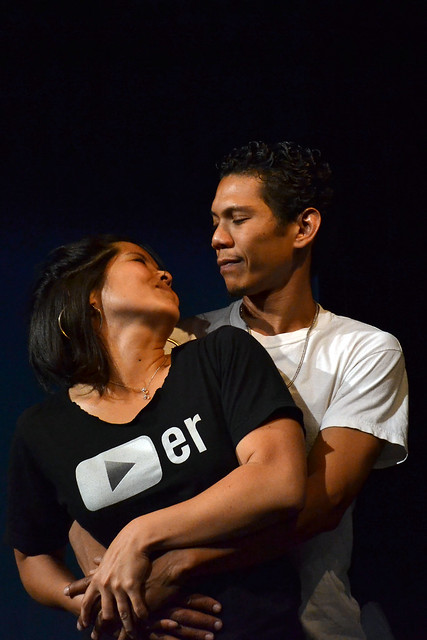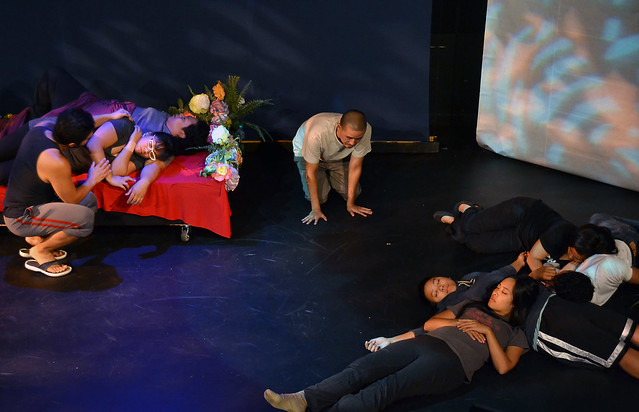
The dry percussive sounds of the kulintang punctuated every graceful leap and sweeping movement as Hermia tried to escape from the unyielding clutch of Demetrius. At Bindlestiff Studio on Sixth and Howard Streets, an SF State production gives form to Shakespeare’s metaphysical world of fairies, spirits and even the “Manananggal.”
Shakespeare’s tale of lovers’ entanglement and division of class in “A Midsummer Night’s Dream” gets a retelling in this re-imagining of the classic comedy.
SF State theatre arts student Lorna Velasco, 36, directed “A Pinoy Midsummer,” which applies Filipino folklore and culture into the plot devices of this Elizabethan play. As Velasco’s master’s degree creative project, she formed an all-Asian cast to play these classical roles.
“Very rarely do you see actors of color cast in classical plays. Almost always if there is an actor of color, they are peripheral actors,” said Velasco. “For myself, it was really important for us to take on the challenge of doing a production that’s more classic.”
When choosing to adapt “A Midsummer Night’s Dream,” Velasco was interested in illustrating the striking parallels between its world of classicism and old-time folklore with the current social breakup and culture in the Philippines.
“Coming from a working-class family in the Philippines, I really saw a discrepancy between the rich and the poor. You see it everywhere,” Velasco said. “When you go shopping at SM mall, there’s a lot of people, but no one’s inside the stores buying anything.”

Three sets of characters make up the class division within “A Pinoy Midsummer” — the Athenians, the rude mechanicals and the fairies.
The Athenians are the ruling class, which consists of the Duke and the Duchess, who are about to get married. But their marriage becomes mired in the quarrels among the lovers within this class.
The rude mechanicals play the working lower class of citizens who are carpenters, menders and tinkers among other things. This group of characters attempt to assemble a play together to show the Duke and the Duchess at the eve of their wedding, to become rich. This set of characters only speak Tagalog until the final scene of the play as they perform.
“In the Philippines, classicism is the major social stratification as opposed to here in the U.S. It’s more like race. A lot of that had to do with the history of colonization, and that’s also played on in this play,” said Aureen Almario, who plays Hermia.
The fairies compose the metaphysical world with the purpose of blessing the wedding. But they also are caught up in their own struggle for power. The fairies add an additional layer of Filipino cultural subtext throughout the play.
“At that time in the 1500s, the belief in fairies was still very palpable, but nowadays it isn’t. No one believes in fairies, except Filipinos.” Velasco said. “We believe in ‘Manananggal,’ ‘Tikbalangs,’ and the little old man who lives on a mound. We believe in that. I believe in that.”
Throughout the play, the Athenians don’t respond to the rude mechanicals in Tagalog. This adaptation emphasizes that language possesses a direct connection to one’s social class.
“Class comes with education and accessibility to different resources that someone who doesn’t have that is not gonna get. English probably is not the native language in this Athenian world, but we’re taking it on because we’re the higher class,” said Julie Kuwabara, who plays Helena. “And so the rude mechanicals are the ones who are the lower class. They don’t have the access to it, so they are speaking in Tagalog.”
Velasco said it was a struggle when translating portions of Elizabethan English into working-class Tagalog. After trying to decipher the text of other Tagalog translations of “A Midsummer Night’s Dream,” Velasco wanted to use a language that any audience member would understand. Working-class Tagalog fit the script well, said Velasco.
“The rude mechanicals’ portion is all in Tagalog. Lorna was very ambitious and translated some of the lines in Tagalog,” said Chuck Lacson, who plays Peter Quince, a rude mechanical. “It’s basically looking at Shakespeare through the lens of Filipino culture. It’s really exciting.”
With extensive knowledge and experience in physical theater ever since she starred in her first production at Bindlestiff Studio at age 17, Velasco wanted to incorporate traditional Filipino music, as well as dance, in the play.
“We wanted to include Filipino indigenous music to the play because we’re trying to create a representation of our cultural roots,” said Augusto Gonzales, who is the musical director. “It’s kind of a hodgepodge of gongs, guitars, bamboo and all kinds of stuff. It’s interesting, for sure.”
Although a portion of “A Pinoy Midsummer” is translated into Tagalog, Velasco assures that any audience will be able to interpret the play.
“Even if they’re a non-Tagalog speaker, they’ll get it and they’ll understand it,” Velasco said. “That was our goal. It needed to be understood by Filipinos and it needed to be understood by non-Filipinos.”
“A Pinoy Midsummer” will be playing from Sept. 6-15 at Bindlestiff Studio, 185 Sixth Street. Thursday and Saturday showings are at 8 p.m., and Saturday matinee is at 2 p.m. General admission is $15, and students and seniors are $10. Tickets are sold at Brownpapertickets.







